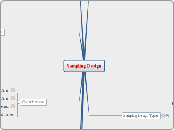Sampling Design
How it relates to the student project study
Sampling Process
Select ...
Relative Population
Appropriate Sampling Units
Sampling Frame
Sample Design
Size of Sample
Homogeneity of the Unit
Confidence
Precision
Statistical Power
Analytical Procedure
Costs, Time, & Personnel
Sampling Plan
The Actual Sample
Considerations
Incidence Rates
Responce Rates
Screening
International Issues
Choice Criteria
Cost
Accuracy
Time
Acceptance of Results
Generalizability of Results
Sourced from Davis, 2005
Terminology
Population
Sample
Sampling Units
Element
Individual Elements
Set of Elements
Sampling Frame
Sampling Plan
Sampling Errors
Procedural Errors
Imprecision
Rationale
Resource Constraints
Accuracy
Destructive Measurement
Finite
Infnite
Parameter/ Statistic
Efficiency
Statistical
Sample
Strata
Sampling Design Types
Probability
Simple Random
Obtain a List of the Population
Choose a Device
Ensure Independant Selection Processes
Systematic
Multistage Random
Stratified
Proportionate
Optimum Allocation
Disproportionate
Cluster
Divide Population
Mutually Exclusive
Exhaustively Inclusive
Select Random Sample Clusters
Stratified Cluster
Repetitive
Non-Probability
Judgement
Quota
Convenience
Snowball
